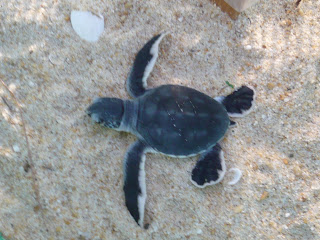Predators and Prey, and Catching Turtles
By ELEANOR STERLINGAs I said in a previous post, scientists have noted a pattern of a higher ratio of “standing” predator to prey biomass on the atoll, which contrasts with most other marine and terrestrial ecosystems (for example, think about the small ratios of top mammalian predators to grazers on the African savanna). They hypothesize that extremely high rates of production in the prey, including algae; corals, clams and other invertebrates; and smaller fish, supports the predators. This is coupled with high rates at which prey are eaten or otherwise die (called “turnover”). Another possibility is that the larger-bodied fish can live on relatively low amounts of food for many years, even decades, when protected from fishing.
But this focuses on one habitat and one set of species interactions whereas there are many more relationships at Palmyra. Mobile predators, such as sea birds and pelagic sharks, may also be feeding elsewhere, or feeding on food arriving from elsewhere, emphasizing the connections across near-shore, deep-water and terrestrial components of the larger ecosystem. Researchers studying parasites are further showing how complex these food webs are. In a parasite-conscious food web, the larger predators are prey for small-bodied parasites. Graphically, “food chains” are in reality more like a bowl of spaghetti.
Green and hawksbill sea turtles at Palmyra are both predators and prey and thus we are interested in their population size for both basic ecology as well as conservation reasons, but counting turtles is no easy task. During our first several years of research on sea turtles at the Palmyra Atoll National Wildlife Refuge we only observed turtles at a distance while we determined how best to tally the population. They do not come ashore here like they do at basking sites in Hawaii or at nesting sites around the world; rather they range across the flats surrounding the islets, in the lagoons, and along the deeper fore-reef areas. They are also quite skittish, possibly because of high predator pressure, and if you approach too closely they zip away as fast as their flippers will carry them.
Ideally we would do a full census of all the individuals, meaning we count every single individual, but that is next to impossible given their behavior. We therefore count a subset and then extrapolate from this subset to the whole. Researchers have a number of population estimation techniques and we are using several of them for the turtles.
Our main technique relies on a mark-recapture system. But first we have to capture them safely for both the turtles and for us. We received special training from sea turtle specialists at the National Oceanographic and Atmospheric Administration for care and handling of turtles. We use nets, which entails setting up a short net parallel to shore and waiting for turtles who are heading out to sea, and we capture by hand, which takes excellent hand-eye coordination in order to grasp the front and back of the shell as a turtle whizzes past. Both generally involve a lot of splashing.
Once we have the turtles in hand, we ensure they are comfortable and kept cool (or warm if it is cold and rainy) and we work quickly to measure and weigh them, check for parasites or other organisms living on the shell or skin of the animals, assess their overall body condition and look for tumors. We paint numbers on the turtles that last for only a few months but are helpful for us to quickly recognize that we have already caught an animal.
We also place small acoustic tags on the shells of some of the turtles. These transmitters send information to a receiver array that the Palmyra Atoll Research Consortium has placed throughout the lagoon areas and let us know when turtles have passed by. We can use this information to understand finer-scale movements of turtles around the atoll. To understand how the sea turtle population at Palmyra connects with turtle populations across the Pacific, an important goal for our funders, the National Oceanographic and Atmospheric Administration, we use a different kind of tag that sends signals to satellites. We have placed several satellite tags on adult males in the hopes of finding out where they go. We complement the satellite data with genetic analyses, which can help us locate nesting sites for these populations.
When we get back from working with the turtles each day, we still have a full load of work ahead of us, as we need to clean and restock our kits and prepare the samples we have taken, process photos, and enter data into spreadsheets.
In the evenings we also have lots of work reminding us of the outside world, including finishing revisions on a journal article some of us are writing and preparing peer reviews of two manuscripts by other authors.
We have had really great luck this week with the turtles and were able to catch several turtles each day. We finally (and to a great amount of rejoicing) recaptured several animals. Once we get an adequate number of recaptures we can start to measure growth rate in addition to estimating population size, but we still have a tiny ratio of recaptures to captures.








